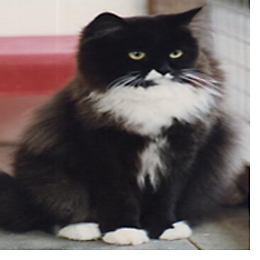 According to some, the tuxedo cat’s markings of black and white symbolize harmony and peace of spirit. In the case of the two tuxedo felines that lived in my house over the years, I would say that sometimes that’s true and sometimes it’s not! (I had one male and one female and they were as different in personality and temperament as night is to day.) Still, the tuxedo cat is quite distinct from others of its ilk and its markings are as diverse as any that could ever be mixed from an artist’s fine palette.
According to some, the tuxedo cat’s markings of black and white symbolize harmony and peace of spirit. In the case of the two tuxedo felines that lived in my house over the years, I would say that sometimes that’s true and sometimes it’s not! (I had one male and one female and they were as different in personality and temperament as night is to day.) Still, the tuxedo cat is quite distinct from others of its ilk and its markings are as diverse as any that could ever be mixed from an artist’s fine palette.
The derivation of the word seems obvious, as like penguins, these creatures appear to be formally garbed for some special occasion to which they may or may not have been invited. It may be a place where humans are never expected to go, and that would include Fred Astaire despite his charming his top hat and dancing tails! Sometimes referred to as the “Jellicle cat,” this term derives from a fictional tribe of black and white felines created by T.S. Elliot in “Old Possum’s Book of Practical Cats,” which was first published in 1939.
Technically, a tuxedo cat is a bi-colored feline with a white and black coat. Most are also known as “black mask cats” because of the black patch that is usually found over the eyes and often covers the entire head. The true tuxedo cat has a solid black coat with white fur limited to the paws, belly, chest, throat and chin. Sometimes, these cats give the illusion of sporting goatees, which occurs when the black coloration surrounding the lower jaw is prominent. The belly is usually largely white and if the neck and chin are white, generally the front paws are also white.
Do YOU own such a cat? Please share your experiences
Related Articles:
“Sylvester: The Tuxedo Cat”
http://blogs.families.com/admin/b2browse.php?blog=28&p=8169

